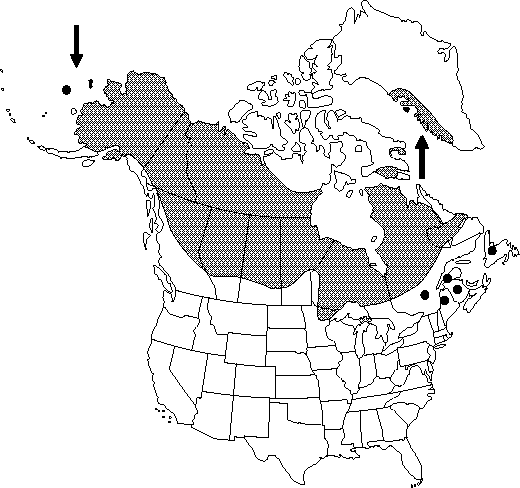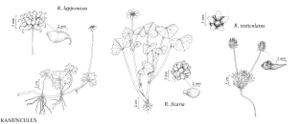Difference between revisions of "Ranunculus lapponicus"
Sp. Pl. 1: 553. 1753.
GeoffLevin (talk | contribs) (Added Nunavut to distribution; treatment was published before Nunavut split from N.W.T.) |
GeoffLevin (talk | contribs) m (Fixed Nfld. and Labr. distribution to match map in printed version.) |
||
| Line 27: | Line 27: | ||
|habitat=Boggy places and lakesides in tundra, muskeg, and boreal forest | |habitat=Boggy places and lakesides in tundra, muskeg, and boreal forest | ||
|elevation=0-900 m | |elevation=0-900 m | ||
| − | |distribution=Greenland;Alta.;B.C.;Man.;N.B.;Nfld. and Labr. | + | |distribution=Greenland;Alta.;B.C.;Man.;N.B.;Nfld. and Labr.;N.W.T.;Nunavut;Ont.;Que.;Sask.;Yukon;Alaska;Maine;Mich.;Minn.;Eurasia. |
|discussion=<p>Starving individuals among western Eskimo groups ate the soaked plant of <i>Ranunculus lapponicus</i> as a dietary aid before consuming other food (D. E. Moerman 1986).</p> | |discussion=<p>Starving individuals among western Eskimo groups ate the soaked plant of <i>Ranunculus lapponicus</i> as a dietary aid before consuming other food (D. E. Moerman 1986).</p> | ||
|tables= | |tables= | ||
| Line 46: | Line 46: | ||
|habitat=Boggy places and lakesides in tundra, muskeg, and boreal forest | |habitat=Boggy places and lakesides in tundra, muskeg, and boreal forest | ||
|elevation=0-900 m | |elevation=0-900 m | ||
| − | |distribution=Greenland;Alta.;B.C.;Man.;N.B.;Nfld. and Labr. | + | |distribution=Greenland;Alta.;B.C.;Man.;N.B.;Nfld. and Labr.;N.W.T.;Nunavut;Ont.;Que.;Sask.;Yukon;Alaska;Maine;Mich.;Minn.;Eurasia. |
|reference=None | |reference=None | ||
|publication title=Sp. Pl. | |publication title=Sp. Pl. | ||
Latest revision as of 16:00, 29 February 2024
Stems prostrate, buried, rooting nodally, glabrous, not bulbous-based. Tuberous roots absent. Basal leaf blades reniform, deeply 3-parted, 1.1-2.6 × 1.6-4.3 cm, segments undivided or 1× cleft, margins crenate, apex rounded. Flowers: receptacle glabrous; sepals spreading or reflexed from base, 4-7 × 2-5 mm, glabrous; petals yellow, 5-6 × 2-3 mm. Heads of achenes hemispheric, 5-7 × 8-10 mm; achenes 3.8-4.2 × 2-2.2 mm, glabrous; beak persistent, lanceolate, curved, tip hooked, 1.6-2.4 mm. 2n = 16.
Phenology: Flowering late spring–summer (Jun–Jul).
Habitat: Boggy places and lakesides in tundra, muskeg, and boreal forest
Elevation: 0-900 m
Distribution

Greenland, Alta., B.C., Man., N.B., Nfld. and Labr., N.W.T., Nunavut, Ont., Que., Sask., Yukon, Alaska, Maine, Mich., Minn., Eurasia.
Discussion
Starving individuals among western Eskimo groups ate the soaked plant of Ranunculus lapponicus as a dietary aid before consuming other food (D. E. Moerman 1986).
Selected References
None.
